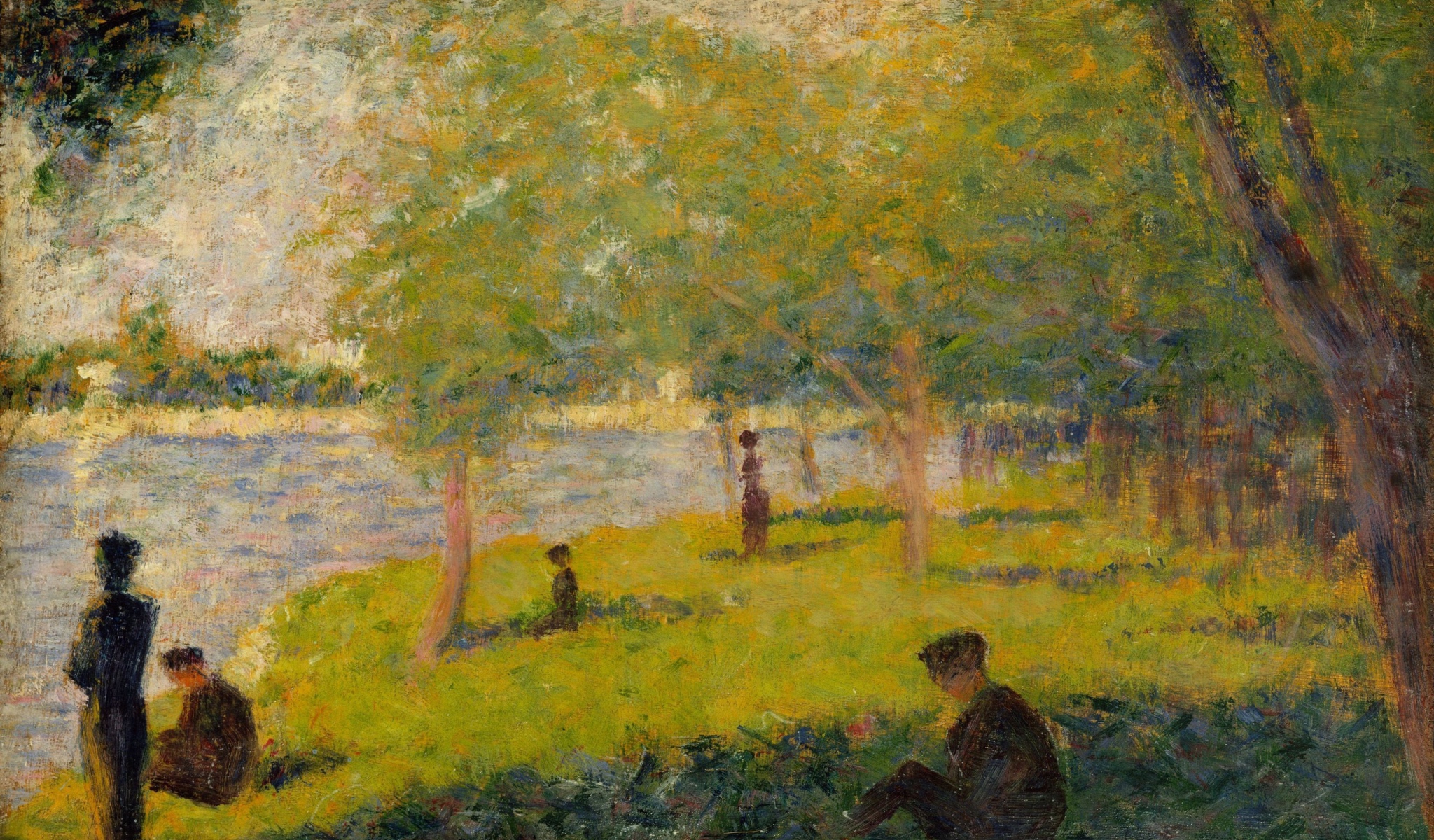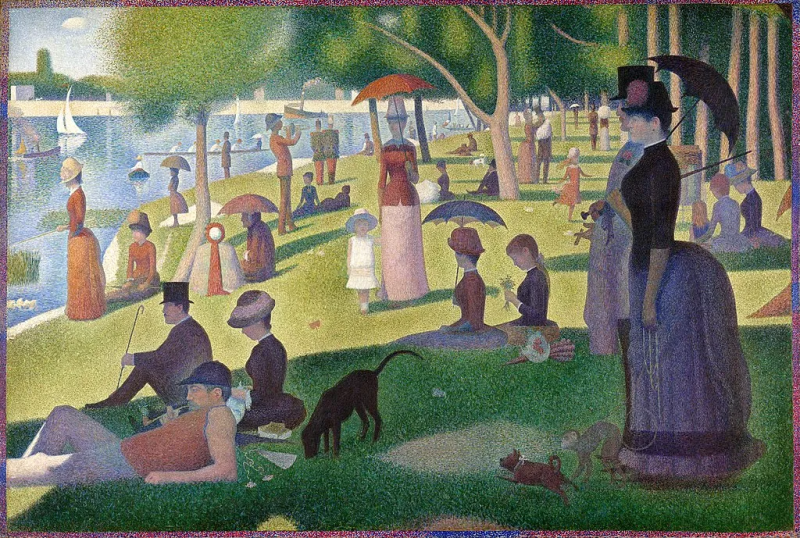Political Pointillism
by Thomas Buckley at Brownstone Institute

Thanks again to the California Globe for running this piece. You can visit the website at: https://californiaglobe.com/
If you happen to be at the Art Institute of Chicago, you can see Georges Seurat’s pointillist masterpiece, A Sunday Afternoon on the Island of La Grande Jatte.
If you are not in Chicago, here’s the painting. Anyway, you’ve seen it before:

Stand close and all you can see are the dots of paint Seurat used – 220,000 dots spread over 65 square feet of canvas in fact. That’s 23 per square inch and is a pointless, as it were, blur (like all pointillist works) if you are too close.

But step back and the dots begin to form shapes (note – detail from a different painting).
Step further back, and they start looking like something recognizable.
Take a few more steps back and there it is – you see everything. You see the people, the river, the park.
And that is the point (again as it were,) to take them all in at once and see the whole picture.
And that is today’s evil political landscape – it is all there to see if one takes a step back and sees it as a whole.
It didn’t used to be this way, but now – since the powers that be do not have to hide anymore – all of the structures of power are visible…if you know how to look. And it’s why you are mocked and censored and denigrated if what you see – the truth, the painting – is not what you are supposed to see.
Of course, one can become too obsessed with one issue or matter or event (or dot) and miss the totality of the picture; conversely, see only the totality and you miss the discrete points, the specific actions, and nefarities involved in its creation.

But there are no red “conspiracy” evidence strings needed anymore and connecting the dots is no longer necessary as those in power are now more than happy to show you everything. Because they are now so confident that they can control the picture, no matter the dots. Or, at least, successfully brand as a lunatic anyone who does not see what they say is the picture.
In fact, working to have people see the dots and try to make distinct connections between them is why they are so open now – you get to call anyone who does that an obsessive, a person missing the greater good, a conspiracy theorist.
And if you are successfully able to take a step back and see the totality you will be branded as someone who doesn’t understand the detailed – and absolutely completely trust us on this – necessary and proper processes involved in societal governance (by official governments or the ever-growing unofficial governments).
It’s win-win for those in charge, lose-lose for those not. If you see the truth you’re evil and nuts; if not, that’s great.
Each of the dots, each a single color, are individual elements in making the painting work as a whole. Humans are hard-wired to see patterns (from recognizing faces to making sure we are not hit by cars or eaten by lions) and that is why this style of painting – mostly now fallen by the wayside, in part because it’s really complicated and difficult – works.
And it is what actual reporters used to do – see the whole picture, capture it, and let the public know what it looks like. No more – the “journalists” of today are taking their gesso brushes and wiping out millions of dots, vast swathes of society.
Censorship a problem? Don’t worry – it’s just a few dots missing. Sure, it makes a painting of people in the park on a Sunday look like dogs on the moon, but that’s what the power structure wants people to think. Either the public gets it wrong and is told they are wrong so they will shut up or they see the purposeful changes and are called loonies who are seeing the wrong picture.
Or they go along with it as presented.
This preventing of seeing the real dots that make up the picture is intentional, hence its obviousness. If the dots are shaded differently or missing or “unavailable for comment” it is still the viewer – the public – that is blamed for failing to understand. It is as if you were shown an oval with two black dots in the upper middle and berated when you immediately realize it was a face (or an ice hockey rink or whatever).
The dots are obvious in California, but the San FranscicaMento blob tells you are seeing them wrong – you are putting them together improperly.
Free stuff to create a permanent underclass? Nope – nothing at all to do with votes or cheap maids. We’re just being nice.
The imposition of cultural changes that – when it answers honestly – the vast majority of the public doesn’t want? You are focusing on the dots and missing the big picture because you cannot see through your bigoted hatred.
A state senator switches parties to become a Republican and is immediately hit with a very nebulous “harassment” lawsuit by her former, but presumably still a Democrat, chief of staff?
That’s a point of power and vengeance; in other words, a red dot.
But what if California is a “detail section” of the national and international picture? Step back even further and you will see that is so.
The media refusing to tell the public the true color of the dots and the true shape of the picture is one aspect, the international power elite creating a dependent, rental life is another (that’s because you will never own the painting of reality – you just get to look at their version).
So there are actually two different paintings for two different worlds – the controlled world and the controller world. Like in the analogy of Plato’s Cave, the controlled world – the controlled painting, the controlled dots – the public is only allowed to see is a vague shadow of the controller world.
Just enough to keep you calm, just enough to let you think you are in fact control, and just enough to arouse the curiosity of some people who try to see the whole painting.
And just enough true dots so as to be able to call the people that still see people as lunatics, fringey, extremists, liars, and uncaring thieves.
And then the dots are moved and the game starts again and again and then is over.
Unless we take up the brush ourselves.
Republished from the author’s Substack
Political Pointillism
by Thomas Buckley at Brownstone Institute – Daily Economics, Policy, Public Health, Society
Disclaimer
Some of the posts we share are controversial and we do not necessarily agree with them in the whole extend. Sometimes we agree with the content or part of it but we do not agree with the narration or language. Nevertheless we find them somehow interesting, valuable and/or informative or we share them, because we strongly believe in freedom of speech, free press and journalism. We strongly encourage you to have a critical approach to all the content, do your own research and analysis to build your own opinion.
We would be glad to have your feedback.
Source: Brownstone Institute Read the original article here: https://brownstone.org/


